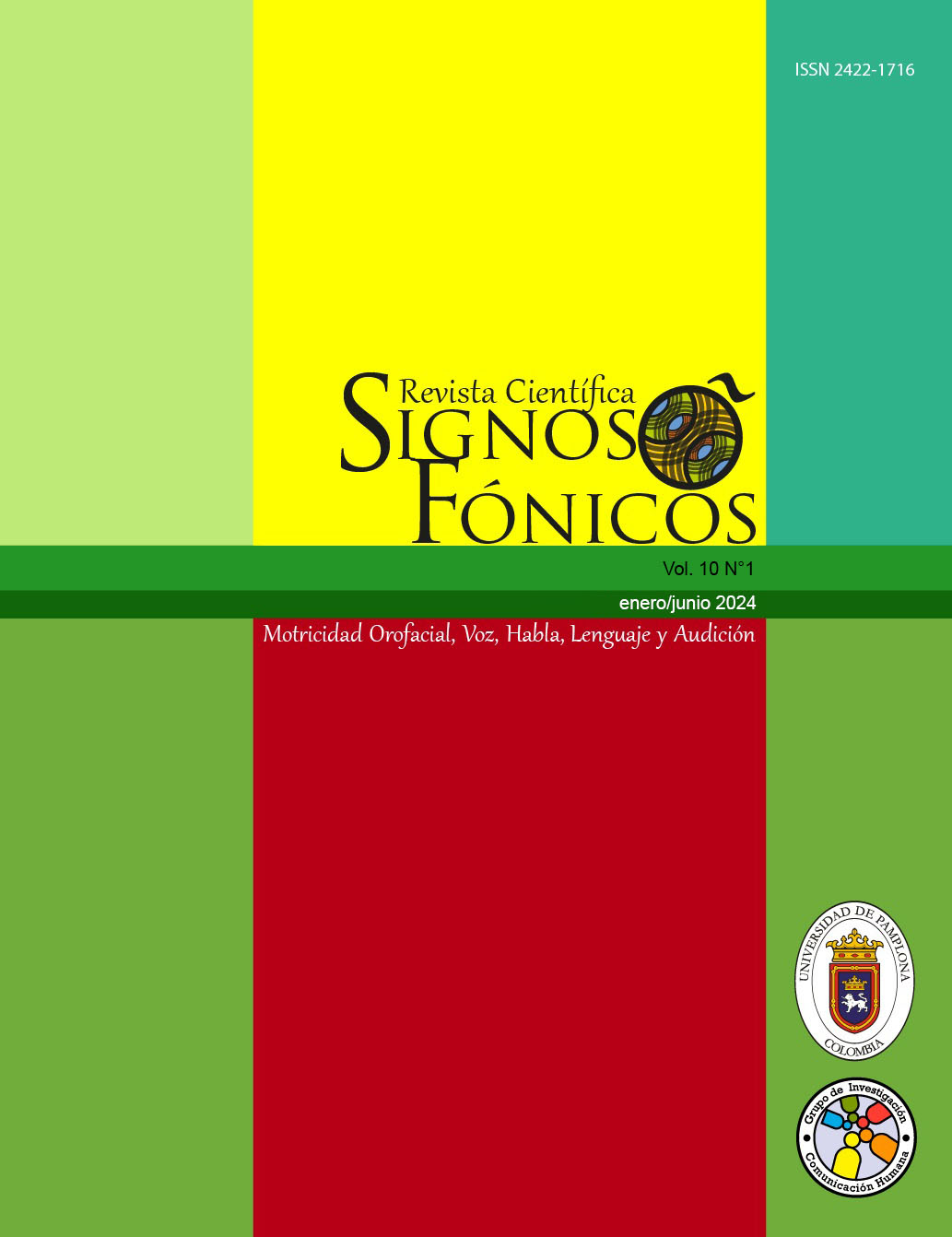To investigate whether bilingualism influences the diagnosis of Developmental Language Disorder (DLD). The particular case of bilingualism (Mapudungun/Spanish) in Chile
DOI:
https://doi.org/10.24054/rcsf.v10i1.3060Keywords:
Language disorders, language evaluations, BilingualismAbstract
Bilingualism in mapuche children in chile is evident. In Chile there are one million people recogniced as mapuche and 60% of them speak mapudungun. Within this 60% there are children with language disorders who are part of chilean language schools (escuelas de lenguaje). Considering this situation, a set of questions related to the capacity of these schools to evaluate bilingual children and see if they are in desadvantage to monolongial children have arisen. This work focus on the relation between bilingualism and language disorders and the situation of schools in Chile. An exhaustive revision of the literature including miths on learning a second language and how language disorders in bilingual children affect was carried out. We emphasize the necessity of updated investigations about bilingualism and language disorders in mapuche children and the adaptation of schools to evaluate and intercede in mapuche children considering their cultural and linguistics characteristics
Downloads
References
Caiceo J. Esbozo de la educación especial en Chile: 1850-1980. Rev Educ y Pedagog [Internet]. 2011;22(57):31–49. Available from: http://aprendeenlinea.udea.edu.co/revistas/index.php/revistaeyp/article/view/9839
Webb W, Adler R. Neurología para el Logopeda. 5°. Barcelona: Elsevier Masson; 2010. 268–269 p.
Ardila A. Ventajas y desventajas del bilingüismo. Forma y Función [Internet]. 2012;25:99–114. Available from: https://www.redalyc.org/pdf/219/21928398005.pdf
Costa A. El cerebro bilingüe. La neurociencia del lenguaje. 1°. Penguin Random House; 2017. 17–51; 101–126 p.
Owens R. Desarrollo del lenguaje. 5°. Madrid: PEARSON; 2003. 373–379 p.
Mendoza E. Trastorno específico del lenguaje (TEL): Avances en el estudio de un trastorno invisible. Madrid: Ediciones Pirámide; 2016. 25–39 p.
Instituto Nacional De Estadísticas. Radiografía de Género: Pueblos originarios en Chile 2017. Unidad Estud Y Estadísticas Género [Internet]. 2018;22. Available from: https://historico-amu.ine.cl/genero/files/estadisticas/pdf/documentos/radiografia-de-genero-pueblos-originarios-chile2017.pdf
Ministerio de planificación y cooperación. Ley 19253 [Internet]. 19253 Chile; Oct 5, 1993. Available from: https://www.bcn.cl/leychile/navegar?idNorma=30620
Contreras C. El castellano hablado por mapuches. Rasgos del nivel morfosintáctico. Estud Filológicos, N°. 1999;34:83–98.
Wittig F. Adquisición y transmisión del mapudungún en hablantes urbanos. Lit y lingüística. 2011;23:193–211.
Olate A, Alonqueo P, Caniguan J. Interactividad lingüística castellano/mapuidungun de una comunidad rural bilingüe. ALPHA. 2013;37:265–84.
Peña-Casanova J. Manual de Logopedia. 4°. Barcelona: Elsevier Masson; 2014. 26–32 p.
Llorenç A., Ahufinger N., Igualada A., Sanz-Torrent M. Descripción del cambio del TEL al TDL en contecto angloparlante. Rev Investig en Logop. 2021 Mar 1;11(Especial):9–20.
Aguado G. TRASTORNO ESPECÍFICO DEL LENGUAJE Retraso del lenguaje y disfasia. 2°. Malaga: EDICIONES ALJIBE; 2004. 15–18 p.
Ministerio deEducación de Chile. Decreto 170 [Internet]. Santiago, Chile; 2010 p. 1–35. Available from: https://especial.mineduc.cl/wp-content/uploads/sites/31/2018/06/DTO-170_21-ABR-2010.pdf
Pávez MM. Test para la Comprensión Auditiva del Lenguaje de E. Carrow. 3°. Santiago de Chile: Universidad de Chile; 2008. 11 p.
Pávez MM. Test Exploratorio de Gramática Española de A. Toronto. Aplicación en Chile. Santiago de Chile: Ediciones Universidad Católica de Chile; 2003. 11–12 p.
Pávez MM, Maggiolo M, Coloma CJ. Test para Evaluar Procesos de Simplificación Fonológica (TEPROSIF-R). 3°. Santiago de Chile: Universidad Católica de Chile; 2009. 11–12 p.
Tejada I. Hacia una redifinición del bilingüismo a través de algunos mitos. Lenguaje. 2012;40(1):257–66.
Ortiz Muñoz A. El bilingüismo en el desarrollo del lenguaje [Internet]. Universidad Central del Ecuador; 2020. Available from: http://www.dspace.uce.edu.ec/handle/25000/22471
Park J, Miller CA, Sanjeevan T, van Hell JG, Weiss DJ, Mainela-Arnold E. Bilingualism and attention in typically developing children and children with developmental language disorder. J Speech, Lang Hear Res. 2019;62(795):1–14.
Castilla-Earls A, Pérez-Leroux AT, Fulcher-Rood K, Barr C. Morphological errors in spanish-speaking bilingual children with and without developmental language disorders. Lang Speech Hear Serv Sch. 2021;52(2):497–511.
Riva A, Musetti A, Bomba M, Milani L, Montrasi V, Nacinovich R. Language-Related Skills in Bilingual Children With Specific Learning Disorders. Front Psychol. 2021 Jan 21;11.
Marini A, Sperindè P, Ruta I, Savegnago C, Avanzini F. Linguistic skills in bilingual children with developmental language disorders: A pilot study. Front Psychol. 2019 Mar 7;10(MAR):1–11.
Shivabasappa P, Peña ED, Bedore LM. Semantic category convergence in spanish– english bilingual children with and without developmental language disorder. J Speech, Lang Hear Res. 2019;62(7):2361–71.
Pua E, Lee MLC, Rickard Liow S. Screening bilingual preschoolers for language difficulties: Utility of teacher and parent reports. J Speech, Lang Hear Res. 2017;60(april):950–68.
Kay-Raining Bird E, Genesee F, Verhoeven L. Bilingualism in children with developmental disorders: A narrative review. J Commun Disord. 2016;63(sep-oct):1–4.
Wealer C., Engel de Abreu PMJ. Assessments of working memory: A tool for differentiating between language disorder and language difference in multilingual contexts? ANAE - Approch Neuropsychol des Apprentissages chez l’Enfant. 2021;33(171):194–204.
Mazon CM, Oppenheimer-Fleury F, Baldisseri AT d’Heursel, Avila CRB de. Efeito do bilinguismo no resgate automático das palavras nos anos iniciais do ensino fundamental. Audiol - Commun Res. 2018;23.
Magdalena D. Trastorno del desarrollo del lenguaje y bilingüismo [Internet]. Universidad de La Laguna; 2020. Available from: http://riull.ull.es/xmlui/handle/915/19742
Nieva S, Rodríguez L, Roussel S. Intervención en el lenguaje con niños bilingües y su familia. Rev Chil Fonoaudiol. 2017;16:1–11.
Gutiérrez-Saldivia X., Quintriqueo Millán S, Valdebenito Zambrano V. Carácter monocultural de la evaluación diagnóstica de necesidades educativas especiales en contexto mapuche. Educ e Pesqui. 2019;45(1):1–18.
Alonqueo P, Wittig F, Huenchunao N. LLEUPEKO TUWÜN. Un estudio exploratorio sobre niveles de competencia en mapuzungun en niños mapuches de la Araucanía. ALPHA Rev artes, Let y Filos. 2017;44(1):119–35.
Garrido, D.; López, B.; Carballo G. Bilingüismo y lenguaje en niños con trastorno del espectro autista: una revisión sistemática. Neurología. 2024;39(1):84–96.
Downloads
Published
How to Cite
Issue
Section
License
Copyright (c) 2024 Juan Alfonso Castillo Espinoza, Dora Diana Luengo

This work is licensed under a Creative Commons Attribution-NonCommercial-NoDerivatives 4.0 International License.











